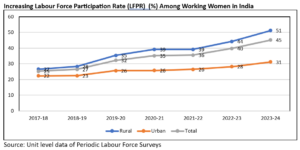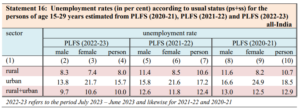
The recently released annual Periodic Labour Force Survey indicates a significant rise in women’s participation in the labour force, increasing from 25% in 2017-18 to 45% in 2023-24, the highest in six years. While this surge is encouraging, it highlights the need to analyse the progress on gender equality, particularly in terms of job security, wage parity, and improved working conditions. A closer examination of the data shows that the rise in female workforce participation has been largely driven by rural women.
The age-wise data reveals interesting trends: in rural areas, younger women have increasingly entered the labour force, while in urban areas, older women have joined the labour market in greater numbers over the past six years.
Female participation lowest among graduates
The increase in female workforce participation has been primarily observed among those with a school-level education, particularly at the primary, middle, and secondary levels. In contrast, women graduates have shown lower participation in the job market, which points to a lack of decent employment opportunities for them. Over the past six years, single women have participated more in the rural labour market, while married women have shown higher participation in urban areas.
Another notable trend is the growing involvement of women from middle and upper-middle consumption classes in the rural labour market, while women from the lowest consumption class have increased their participation in urban areas. This shift reflects both the rising aspirations of rural working-age women and the pressing need for the poorest urban women to engage in the labour market.

In terms of religious groups, Muslim women exhibit higher labour market participation compared to other groups in both rural and urban areas. However, in rural regions, women from OBC (Other Backward Classes) and General caste groups show greater participation, while in urban areas, Scheduled Tribe (ST) women lead in labour market involvement compared to other caste groups.
READ I Nobel laureates unlock the secrets of inequality
Female workforce participation and self-employment
Another key finding from the latest survey is the substantial rise in self-employment among women, alongside a notable decline in wage and casual employment in both rural and urban areas. If job availability for women had genuinely increased, we would expect a corresponding rise in the proportion of women employed as wage earners or casual labourers. The absence of such a trend suggests that the increase in female labour force participation may not be entirely due to improved job opportunities but rather reflects shifts in employment types, with more women engaging in self-employment or family-based work.

The recent increase in female workforce participation cannot be attributed to a sudden rise in job availability in rural areas, as there has been no similar spike in rural male participation. Self-employment includes a wide range of activities where individuals do not work for an employer, such as entrepreneurs, farmers, and local vendors like cobblers or vegetable sellers. Self-employed individuals fall into three categories: employers, own-account workers, and unpaid helpers. Own-account workers operate one-person enterprises, while unpaid helpers work in family businesses without pay.
The increase in female workforce participation is largely due to a growing proportion of women working in own-account enterprises. In rural areas, 71% of self-employed women work from home, compared to only 22% of men, while the figures for urban areas are 69% versus 16%. This highlights a gender divide in entrepreneurship in India, with women entrepreneurs also having limited capacity for job creation. Moreover, the earnings of self-employed individuals are significantly lower than those of salaried employees, across both rural and urban areas and for both men and women.
A concerning trend is the significant drop in public casual employment under the Mahatma Gandhi National Rural Employment Guarantee Scheme (MGNREGS), possibly due to stagnant funding of Rs 86,000 crore, which has remained unchanged for several years. Despite this, the scheme continues to play a crucial role in supporting rural income and employment.
Interestingly, the share of women in total person-days under MGNREGS has increased from 54% in FY 2019-20 to 59% in FY 2023-24, indicating that the scheme has significantly benefited female labourers. Additionally, the number of completed projects under the scheme has risen, with 8.5 million completed in FY 2022 and 7.06 million by early 2023. This underscores the continued importance of MGNREGS for rural employment, particularly for women.
India’s G20 Presidency, with its emphasis on women-led development, has become a pivotal platform for advancing women’s empowerment globally. This approach highlights women’s central role in driving economic and social progress, making gender equality a key component of global development strategies. As women’s involvement in entrepreneurship increases, India must ensure equal access to resources, mentorship, and institutional support for women entrepreneurs.
A greater focus on financial inclusion, social empowerment, and policies aimed at reducing gender disparities in entrepreneurship will help pave the way for more women-led businesses to thrive. Additionally, promoting decent wage employment for women is essential. Expanding budget allocations for programs like MGNREGS can help foster inclusive and sustainable growth, benefiting the economy as a whole. Prioritising these areas will not only promote women’s economic empowerment but also drive broader societal progress.
